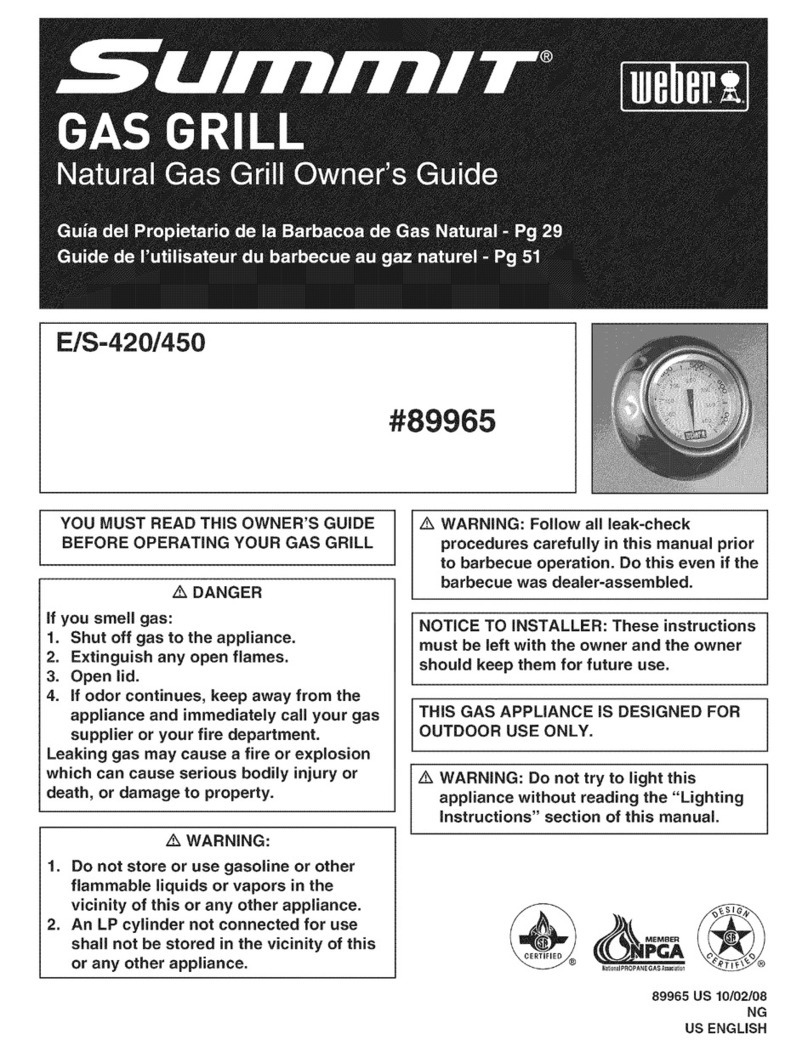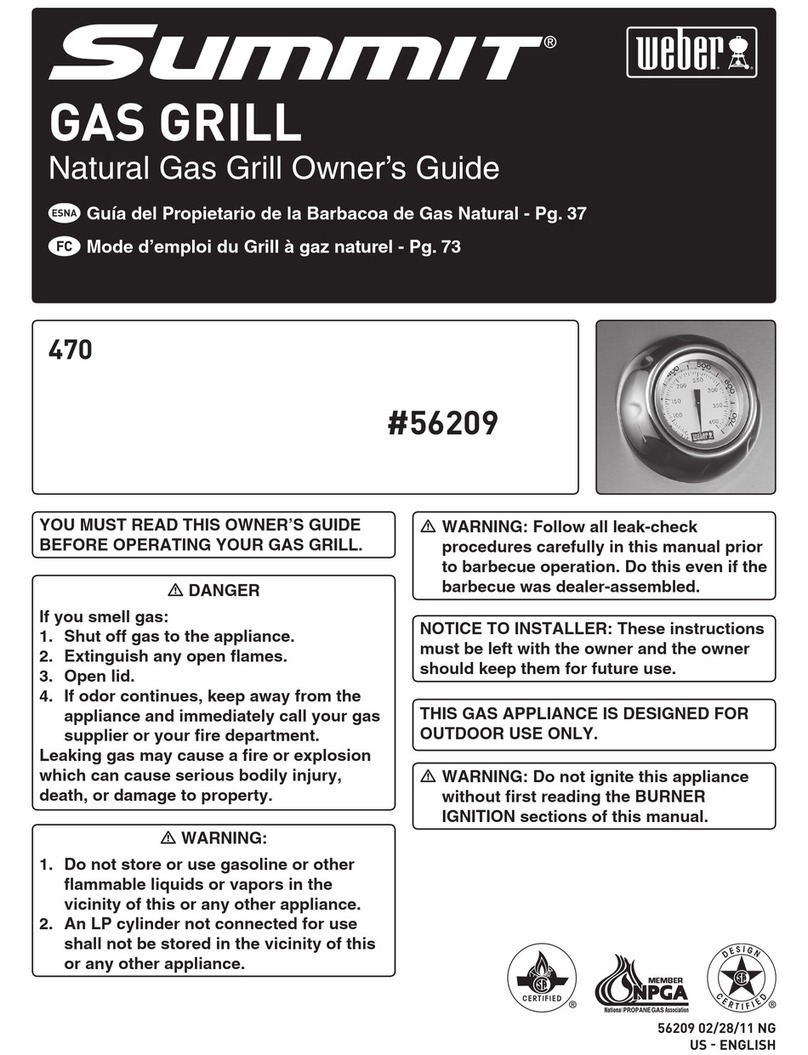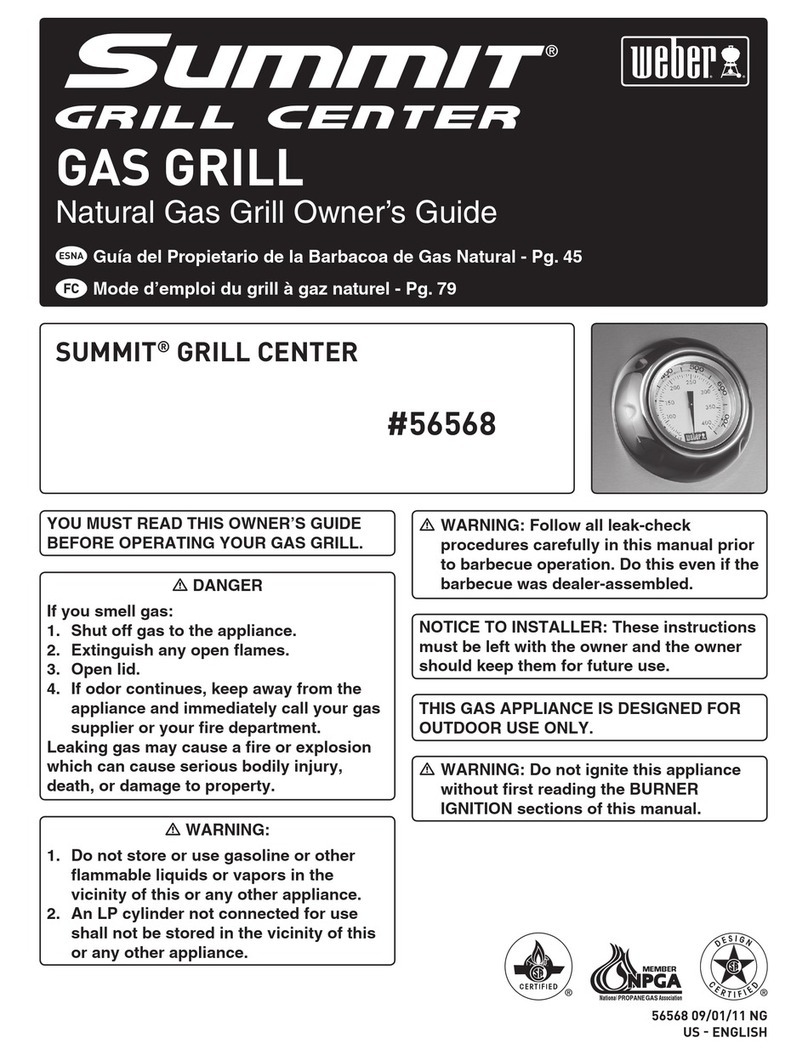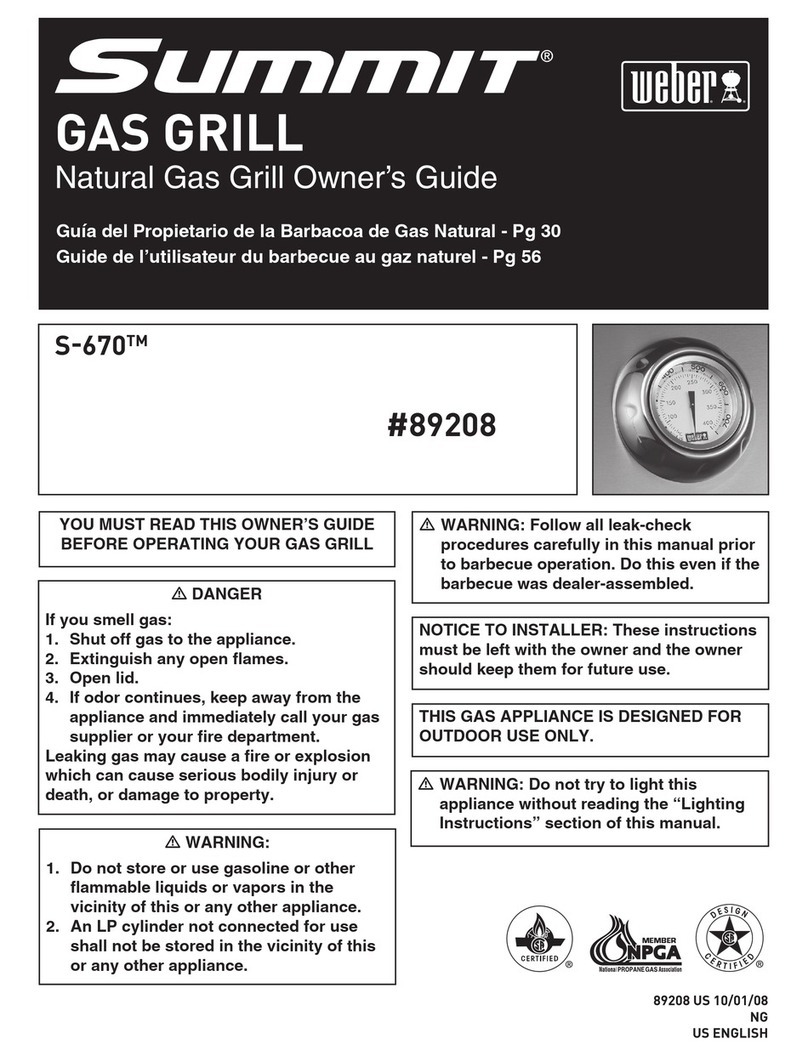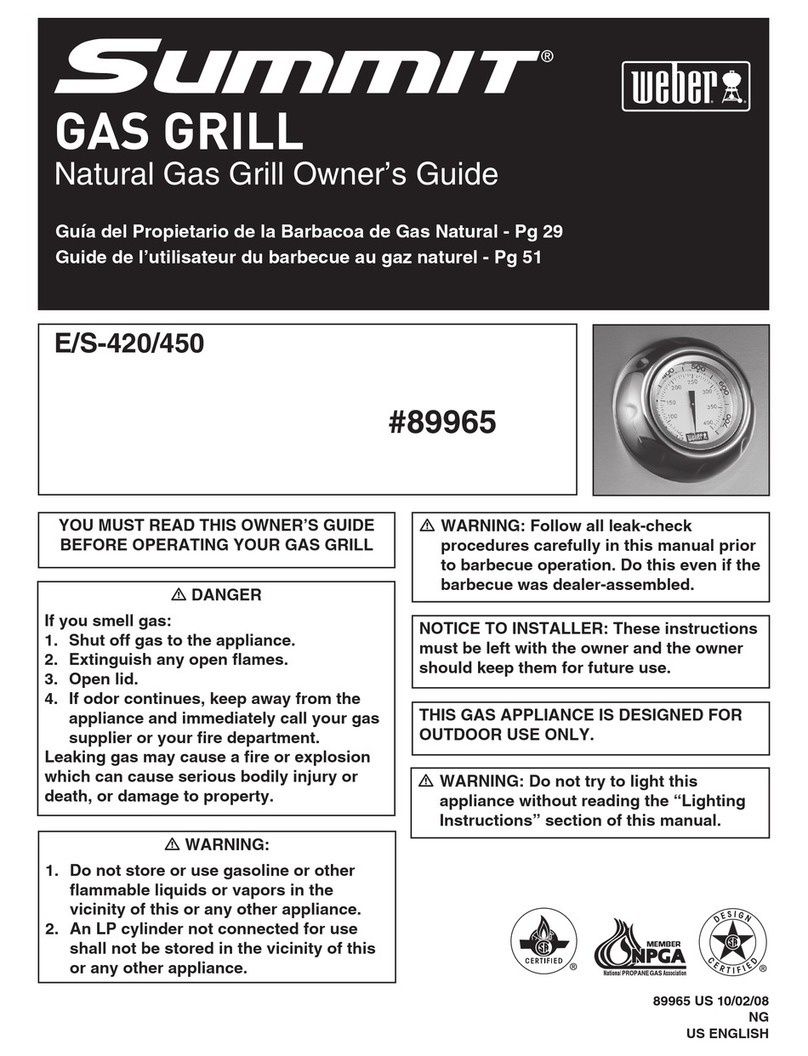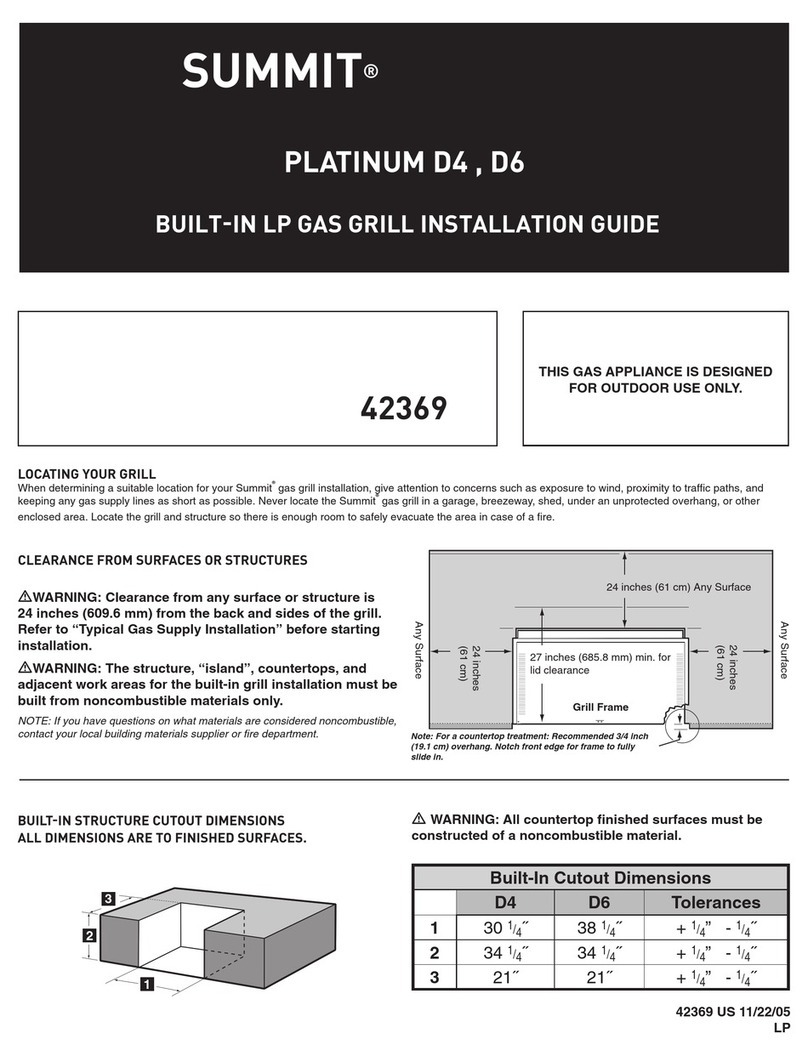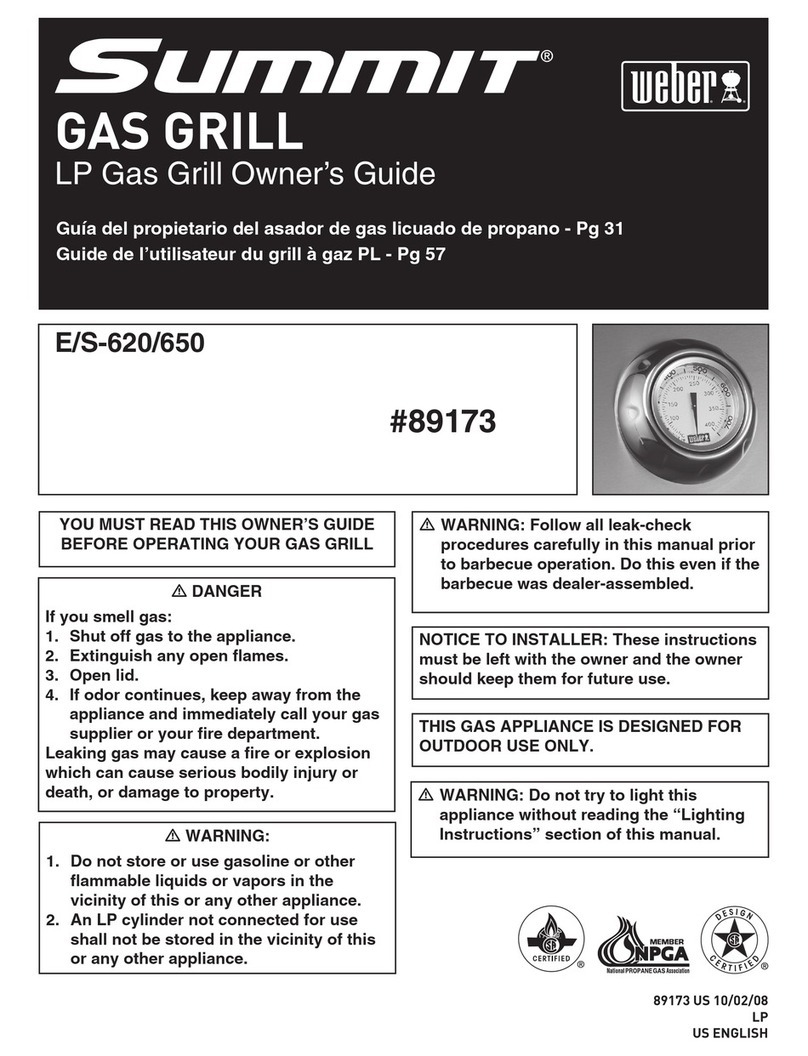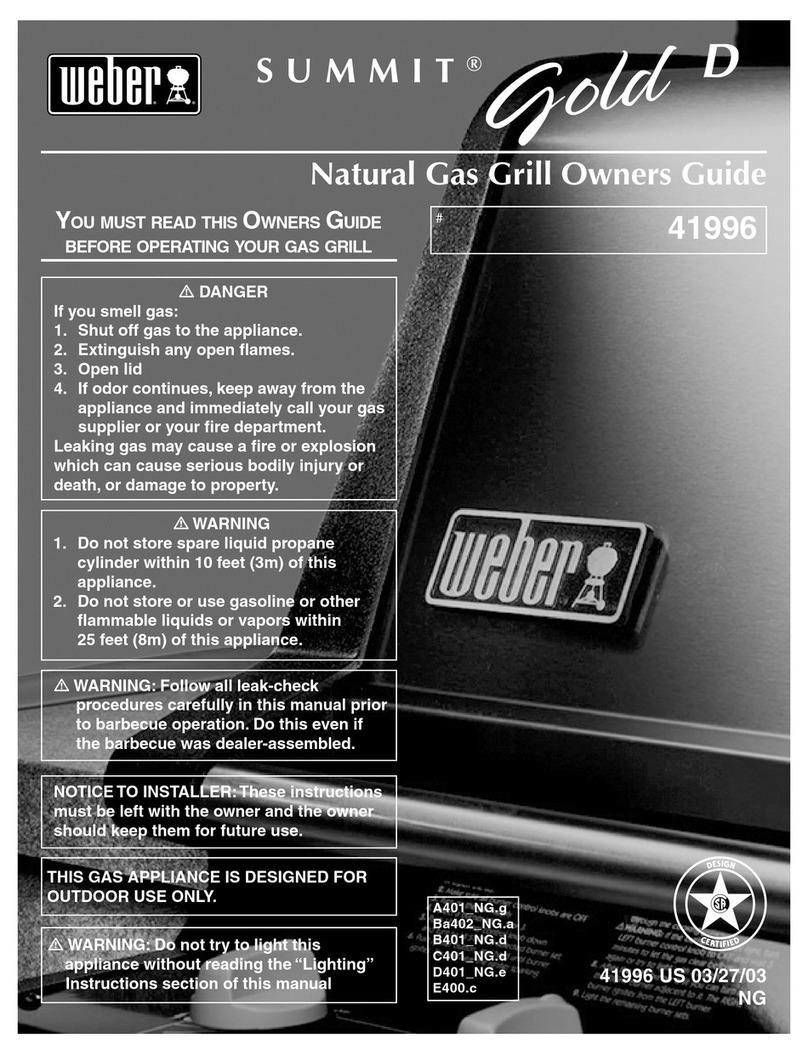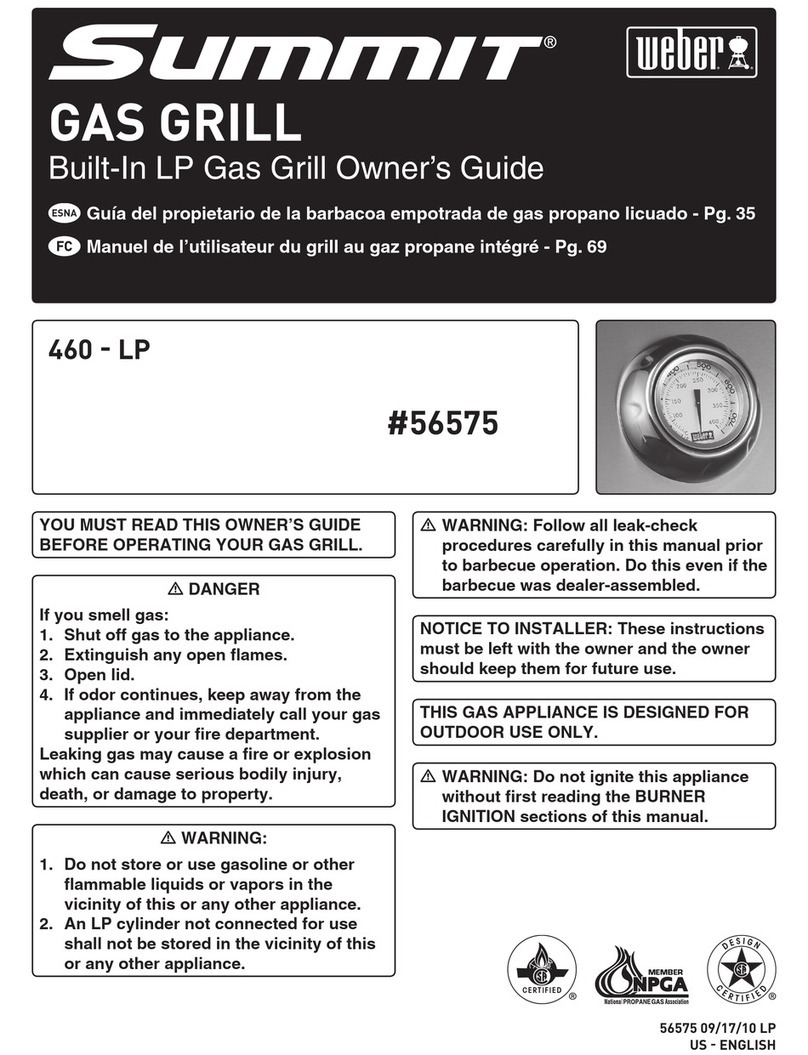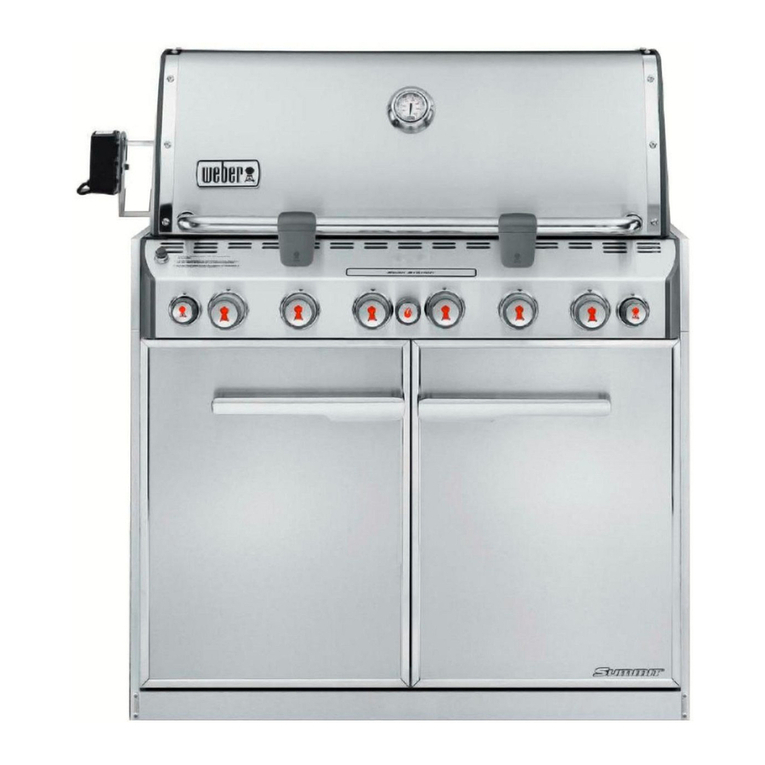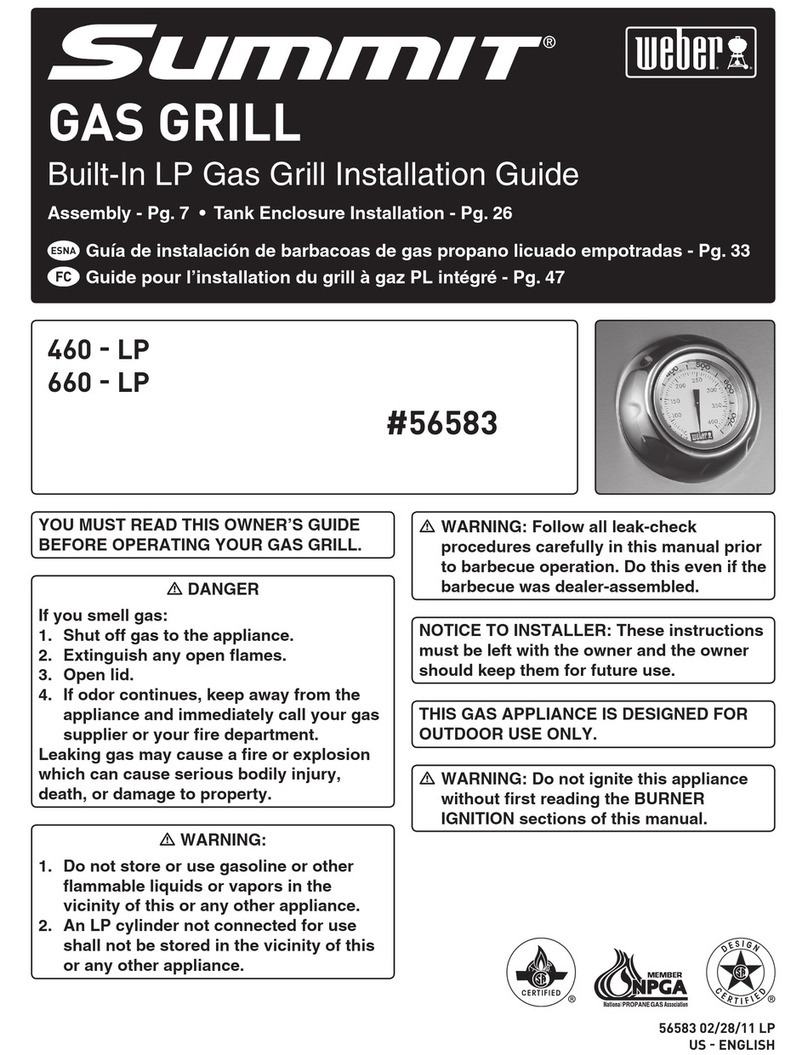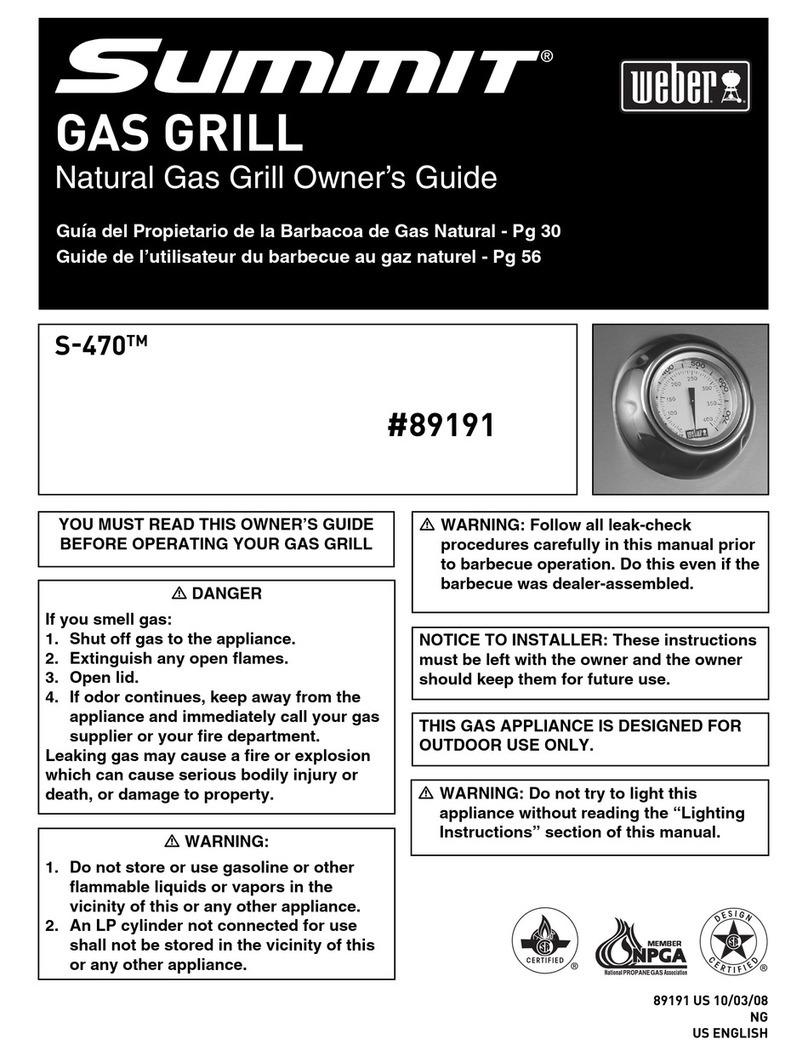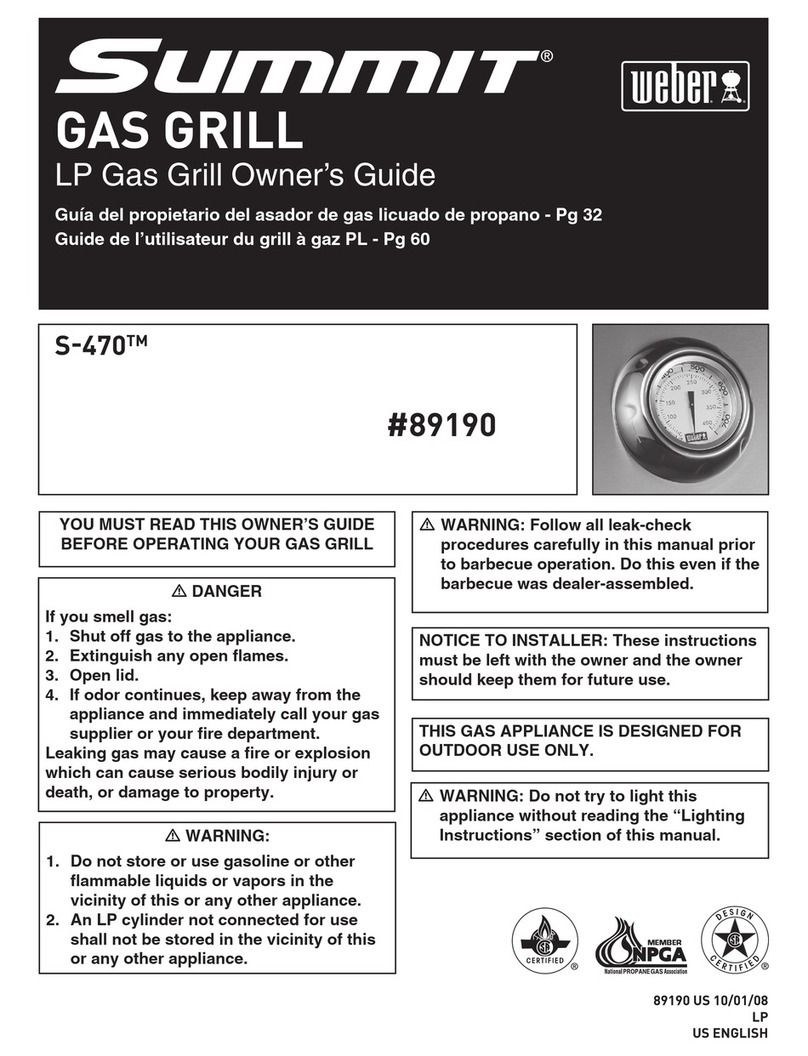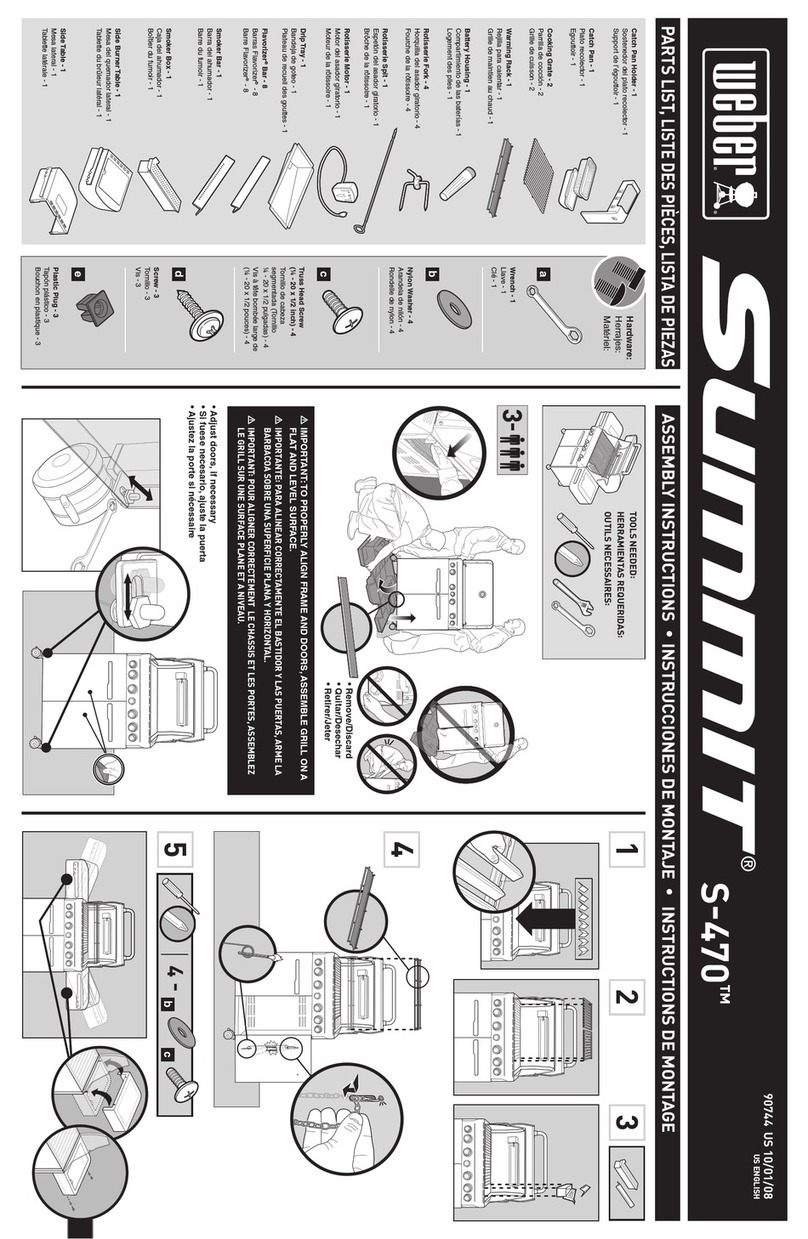
6
WARRANTY
GENERAL INSTRUCTIONS
Your Weber®gas barbecue is a portable outdoor cooking appliance. With the Weber®
gas barbecue you can grill, barbecue, roast and bake with results that are difficult to
duplicate with indoor kitchen appliances.The closed lid and Flavorizer®bars produce
that “outdoor” flavour in the food.
The Weber®gas barbecue is portable so you can easily change its location in your
garden or on your patio. Portability means you can take your Weber®gas barbecue with
you if you move.
Liquid Propane (LP) gas is quicker to use and gives you more cooking control than
charcoal fuel.
• These instructions will give you the minimum requirements for assembling your
Weber®gas barbecue. We therefore request that you read them carefully before you
use the Weber®gas barbecue.
• Not for use by children.
• Do not connect to natural gas supply (city gas). The valves and orifices are designed
exclusively for LP gas.
• Not to be used with charcoal briquettes or lava rock.
• Use only a 3kg-13kg LP gas cylinder.
• In the United Kingdom, this appliance must be fitted with a regulator complying with
BS 3016, having a nominal output of 37 millibars. (Supplied with barbecue.)
• Avoid kinking the hose.
• The length of hose must not exceed 1.5 metres.
• We recommend that you replace the gas hose on your Weber®gas grill every 5 years.
Some countries may have requirements that the gas hose be replaced within less
than 5 years, in which case that country’s requirement would take precedence.
• Any parts sealed by the manufacturer must not be altered by the user.
• Any modification of the appliance may be dangerous.
• Only a nationally approved low-pressure hose and regulator must be used.
• Replacement pressure regulators and hose assemblies must be those specified by
the outdoor cooking gas appliance manufacturer. ◆
STORAGE
• When the Weber®gas barbecue is not being used, turn off the gas supply cylinder
valve.
• When storing the Weber®gas barbecue indoors, disconnect the gas supply line.The
gas cylinder itself is to be stored outdoors in a well-ventilated place.
• If the gas supply cylinder is not removed from the Weber®gas barbecue, the entire
grill and the gas supply cylinder are to be stored in a well-ventilated place outdoors.
• Gas supply cylinders must be stored outdoors in a well-ventilated area out of reach of
children. Disconnected gas supply cylinders must not be stored in a building, garage
or any other enclosed area. ◆
Weber-Stephen Products LLC (Weber) hereby warrants to the ORIGINAL PURCHASER of this
Weber®gas grill that it will be free of defects in material and workmanship from the date of purchase
as follows:
Aluminum castings: 25 years (2 years on paint; excludes fading)
Stainless steel shroud: 25 years
Porcelain-enamelled shroud: 25 years
Stainless steel burner tubes: 10 years
Stainless steel cooking grates: 5 years no rust through or burn through
Stainless steel Flavorizer®bars: 5 years no rust through or burn through
Porcelain-enamelled cast-iron cooking grates: 5 years no rust through or burn through
Porcelain-enamelled cooking grates: 3 years no rust through or burn through
Porcelain-enamelled Flavorizer®bars: 2 years no rust through or burn through
Infrared rotisserie burner: 2 years
All remaining parts: 2 years
when assembled and operated in accordance with the printed instructions accompanying it. Weber
may require reasonable proof of your date of purchase. THEREFORE, YOU SHOULD RETAIN YOUR
SALES RECEIPT OR INVOICE.
This Limited Warranty shall be limited to the repair or replacement of parts that prove defective under
normal use and service and which on examination shall indicate, to Weber’s satisfaction, they are
defective. Before returning any parts, contact the Customer Service Representative in your area
using the contact information on our website. If Weber confirms the defect and approves the claim,
Weber will elect to replace such parts without charge. If you are required to return defective parts,
transportation charges must be prepaid. Weber will return parts to the purchaser, freight or postage
prepaid.
This Limited Warranty does not cover any failures or operating difficulties due to accident, abuse,
misuse, alteration, misapplication, vandalism, improper installation or improper maintenance or
service, or failure to perform normal and routine maintenance, including but not limited to damage
caused by insects within the burner tubes, as set out in this Owner’s Manual.
Deterioration or damage due to severe weather conditions such as hail, hurricanes, earthquakes or
tornadoes, discolouration due to exposure to chemicals either directly or in the atmosphere, is not
covered by this Limited Warranty.
There are no other express warranties except as set forth herein and any applicable implied warranties
of merchantability and fitness are limited in duration to the period of coverage of this express written
Limited Warranty. Some regions do not allow limitation on how long an implied warranty lasts, so this
limitation may not apply to you.
Weber is not liable for any special, indirect or consequential damages. Some regions do not allow the
exclusion or limitation of incidental or consequential damages, so this limitation or exclusion may not
apply to you.
Weber does not authorise any person or company to assume for it any other obligation or liability in
connection with the sale, installation, use, removal, return, or replacement of its equipment; and no
such representations are binding on Weber.
This Warranty applies only to products sold at retail.
Visit www.weber.com®, select your country of origin, and register your
grill today. ◆
OPERATING
mWARNING: This appliance is intended for outdoor use
only and should never be used in garages and roofed or
enclosed porches or verandas.
mWARNING: The Weber®gas barbecue must never be used
under an unprotected combustible roof or overhang.
mWARNING: The barbecue should not be used when
combustible materials are within 60 cm of the top, bottom,
back or sides of the grill.
mWARNING: Your Weber®gas barbecue is not intended to be
installed in or on caravans and/or boats.
mWARNING: When in use, the entire barbecue gets hot. Never
leave it unattended.
mWARNING: Keep electrical mains lead and the fuel supply
hose away from heated surfaces.
mWARNING: Keep the cooking area clear of flammable
vapours and liquids, such as petrol, alcohol, etc., and
combustible materials.
mWARNING: Never store an extra (spare) gas supply cylinder
near the Weber®gas barbecue.
mWARNING: This appliance gets very hot. Take special care
when children or elderly people are present.
mWARNING: Do not move the appliance while it is alight.
mWARNING: Wear protective gloves when using this
appliance. ◆
